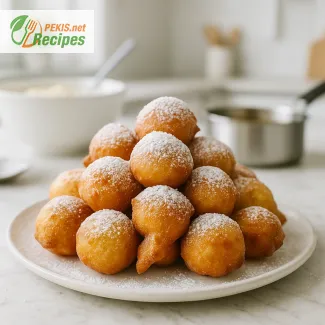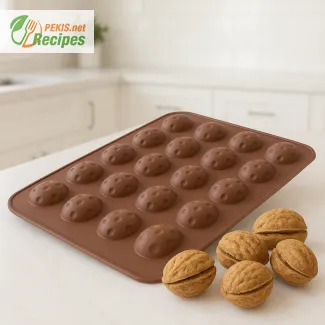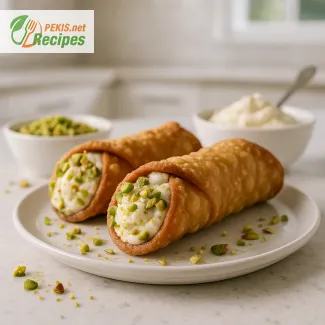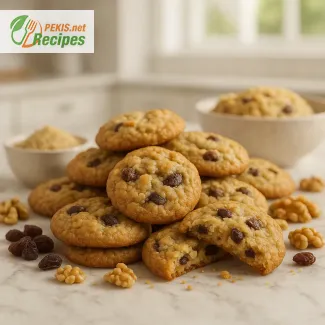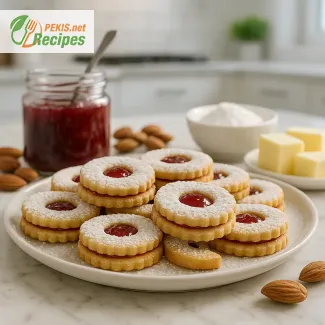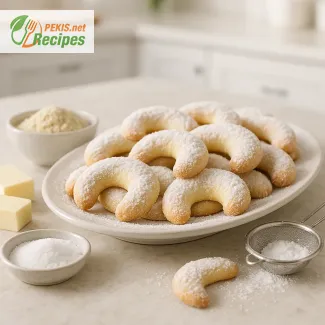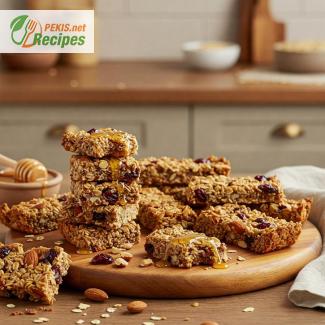
Soft and Chewy Granola Bars: A Perfect Homemade Snack. The Ultimate Balance of Softness and Chewiness. Few snacks can rival the comforting texture and natural sweetness of soft and chewy granola bars. These homemade treats bring together wholesome ingredients, a perfectly balanced texture, and a rich, satisfying flavor that makes them an ideal option for breakfast, mid-day snacking, or even a pre-workout energy boost. Unlike store-bought versions, which often contain artificial preservatives and excessive sugars, these granola bars are made with natural, nutrient-dense ingredients, giving you a healthier alternative without sacrificing taste.
What Makes These Granola Bars Special?
These granola bars are moist, chewy, and full of texture, making every bite irresistible. The combination of toasted oats, nuts, and dried fruits creates a depth of flavor that pairs beautifully with a hint of natural sweetness from honey or maple syrup. A light touch of nut butter enhances their richness while ensuring they hold together perfectly. Whether enjoyed as a quick breakfast on busy mornings or a delicious homemade snack, these bars offer sustained energy and wholesome goodness.
One of the standout features of this recipe is its customizability. You can effortlessly swap ingredients to match your preferences or dietary needs, whether you prefer almonds, walnuts, sunflower seeds, or coconut flakes. Plus, with the option to drizzle chocolate, mix in chia seeds, or add a pinch of cinnamon, you can create endless variations that keep things exciting.
The Key to the Perfect Chewy Granola Bar
Achieving the perfect texture requires a careful balance of wet and dry ingredients. The secret lies in using just the right amount of honey (or maple syrup) and nut butter, which not only provide natural sweetness but also act as a binding agent to keep the bars soft yet firm. Unlike dry, crumbly granola bars, these remain moist and chewy for days, making them an excellent make-ahead snack.
Another crucial element is baking at the right temperature. Low and slow baking ensures that the oats are gently toasted, enhancing their flavor while keeping the bars from becoming too crisp. For those who prefer a no-bake option, simply chilling the bars in the fridge will allow them to set perfectly while maintaining their soft and chewy texture.
A Nutritious and Energy-Packed Snack
These soft and chewy granola bars aren’t just delicious—they’re also nutritionally balanced. Packed with fiber, healthy fats, and protein, they provide long-lasting energy without the sugar crash. Whether you need a mid-day energy boost, a post-workout snack, or a lunchbox favorite, these bars deliver a nutrient-dense bite every time.
- Oats provide complex carbohydrates for sustained energy
- Nuts and seeds add healthy fats and protein for satiety
- Dried fruits offer natural sweetness and fiber
- Honey or maple syrup adds a touch of natural sugar without refined additives
- Nut butter enhances creaminess while binding everything together
For those with dietary restrictions, these bars can be easily adapted. Opt for gluten-free oats for a completely gluten-free version, or swap nut butter for sunflower seed butter to make them nut-free.
Perfect for Meal Prep and On-the-Go Snacking
Homemade granola bars are a time-saver, allowing you to prepare a batch in advance and store them for the week. Unlike processed snacks, which often lose their texture over time, these bars retain their chewiness and freshness when stored properly. Simply wrap them individually for an easy grab-and-go snack or store them in an airtight container to maintain their softness and flavor.
Whether you enjoy them plain, drizzled with dark chocolate, or mixed with superfoods like flaxseeds and cacao nibs, these soft and chewy granola bars are sure to become a household favorite.
- Preheat the oven to 175°C (350°F) and line a 20x20 cm (8x8 inch) baking dish with parchment paper.
- Toast the oats and almonds by spreading them on a baking tray and baking for 8-10 minutes until lightly golden. Remove and let cool.
- Prepare the binding mixture by heating honey (or maple syrup), peanut butter, melted butter, brown sugar, vanilla extract, and salt in a saucepan over low heat. Stir until fully combined and smooth.
- Combine dry ingredients by mixing the toasted oats, almonds, dried cranberries, and optional chia seeds in a large bowl.
- Incorporate the wet ingredients by pouring the warm honey mixture over the dry ingredients. Stir well until everything is evenly coated.
- Press into the baking dish by transferring the mixture to the lined pan and pressing it down firmly using a spatula or the back of a spoon. If adding chocolate chips, sprinkle them on top and press gently.
- Chill and set by placing the dish in the refrigerator for at least 2 hours to firm up.
- Cut into bars once fully set and enjoy. Store in an airtight container at room temperature for up to a week or in the fridge for longer freshness.
The Art of Perfecting Soft and Chewy Granola Bars
Understanding the Balance of Texture and Flavor
Creating the perfect soft and chewy granola bar is all about balance—the right combination of moisture, binding agents, and mix-ins. While store-bought versions often contain preservatives and artificial additives, homemade bars allow for complete control over ingredients, ensuring a healthier and fresher outcome. By carefully selecting sweeteners, fats, and grains, you can achieve the ideal chewiness while enhancing flavor depth and nutritional value.
How Different Ingredients Affect the Final Texture
Each ingredient in this recipe plays a crucial role, and small adjustments can significantly impact the texture, taste, and overall structure of the granola bars. Understanding these elements allows you to customize the recipe to suit personal preferences or dietary needs.
Choosing the Right Oats for a Perfect Base
The type of oats used in the recipe directly affects the texture and consistency of the bars:
- Rolled oats provide a chewier texture and a more structured bite, making them ideal for this recipe.
- Quick oats create a softer, more uniform consistency, but they may lead to bars that are too dense or fragile.
- Steel-cut oats are not recommended as they remain too hard and do not properly bind with the other ingredients.
If you prefer a smoother bite, you can pulse rolled oats in a food processor for a few seconds before mixing them into the recipe.
The Impact of Sweeteners on Flavor and Structure
Sweeteners act as both a flavor enhancer and a binding agent, ensuring that the bars hold their shape while maintaining chewiness. The choice of sweetener will subtly change the final result:
- Honey adds a rich, floral sweetness and helps create a slightly sticky, chewy texture.
- Maple syrup provides a more delicate sweetness with caramel-like undertones, making it ideal for those who prefer a lighter taste.
- Brown sugar enhances deep caramel notes, resulting in a more structured and slightly firmer granola bar.
- Date syrup is a natural alternative that contributes earthy sweetness while increasing fiber content.
For a more intense caramel flavor, a small amount of molasses can be added, but too much will make the bars overly sticky.
The Role of Nut Butter and Fats
Nut butter and fats not only contribute to the binding process but also enhance richness and depth of flavor:
- Peanut butter creates a classic, nutty taste, adding a slightly salty contrast to the sweetness.
- Almond butter brings a milder, slightly floral note that pairs well with dried fruits like cranberries or apricots.
- Cashew butter provides a buttery, creamy flavor, making the bars melt-in-your-mouth soft.
- Coconut oil or butter adds a subtle tropical note, enhancing the overall smoothness of the bars.
For a more neutral flavor, unsalted butter works well, though it provides a firmer texture compared to nut-based alternatives.
Enhancing Flavor with Mix-Ins and Additions
Customizing the granola bars with different mix-ins allows you to create a variety of flavor profiles, each with a unique taste and texture combination.
Adding Nuts and Seeds for Crunch
While the base of these bars remains soft and chewy, adding nuts or seeds brings a delightful contrast in texture:
- Almonds provide a delicate crunch with a slightly sweet, mild flavor.
- Walnuts offer a buttery texture and earthy depth, complementing dark chocolate or dried cherries.
- Pumpkin seeds (pepitas) add a nutty crunch while boosting zinc and magnesium levels.
- Chia or flaxseeds not only enhance nutritional value but also help bind the mixture, improving texture.
Lightly toasting the nuts before adding them can intensify their aromatic qualities, creating a more complex flavor profile.
Elevating Sweetness and Depth with Dried Fruits
Dried fruits provide natural sweetness, preventing the need for excessive added sugars while improving the chewiness of the bars:
- Dried cranberries bring a tangy contrast that balances rich flavors from nut butters.
- Raisins offer a gentle sweetness that pairs well with cinnamon and honey.
- Chopped dates act as an additional binding agent, creating a denser, softer bar.
- Dried apricots lend a bright, fruity note, complementing coconut oil or almond butter.
For an extra layer of flavor, the dried fruit can be soaked in warm orange juice or apple cider before mixing, which enhances their natural juiciness.
Incorporating Chocolate and Spices
Chocolate and spices add warmth, complexity, and indulgence, elevating the recipe beyond a simple snack:
- Dark chocolate chips or chunks melt slightly, creating pockets of richness within the bars.
- White chocolate chips offer a sweeter, creamier contrast when paired with tart fruits.
- A pinch of cinnamon or nutmeg enhances the depth of flavor, making the bars taste more aromatic.
- Cacao nibs provide a bitter, intense cocoa flavor, great for those who enjoy less sweetness.
To prevent chocolate from melting too much, add it after the mixture has slightly cooled, ensuring a better distribution within the bars.
Techniques for Perfecting the Recipe
Beyond ingredient selection, a few key techniques can ensure that the granola bars hold together properly while maintaining optimal texture.
Pressing and Compacting the Mixture
For a firm yet chewy granola bar, the mixture needs to be evenly pressed into the pan:
- Use a spatula or the back of a spoon to firmly pack the mixture before chilling.
- If possible, place a piece of parchment paper over the top and press with a flat object (like the bottom of a measuring cup) to create a more even surface.
- Ensuring a tightly packed mixture prevents bars from falling apart when sliced.
Baking vs. No-Bake Variations
This recipe can be baked or simply refrigerated depending on the desired outcome:
- Baking lightly toasts the oats and nuts, intensifying the richness of the flavors while creating a slightly firmer texture.
- No-bake versions retain more moisture and chewiness, making them softer and closer to energy bars.
If baking, ensure the oven temperature remains low (around 150–160°C / 300–325°F) to prevent over-drying while still helping the bars set.
Customization and Improvements
Whether you prefer your granola bars mildly sweet, intensely nutty, or bursting with fruit flavors, small adjustments can transform the recipe into the perfect personalized snack. By experimenting with ingredient ratios, add-ins, and preparation methods, you can achieve a balanced and delicious granola bar that meets your taste and nutritional preferences.
- Contains nuts (almonds, peanut butter) and dairy (butter, chocolate chips if used).
- May contain gluten if using non-certified oats.
Substitutions for Allergens and Gluten-Free Option:
- Replace peanut butter with sunflower seed butter for a nut-free version.
- Use certified gluten-free oats to make this recipe completely gluten-free.
- Substitute butter with coconut oil for a dairy-free alternative.
- Vitamin E (2 mg): Supports skin health and immune function.
- Magnesium (45 mg): Essential for muscle and nerve function.
- Iron (1.8 mg): Helps in oxygen transport and prevents fatigue.
- Potassium (120 mg): Regulates blood pressure and muscle contractions.
- Flavonoids (from dark chocolate and nuts): Support heart health and reduce inflammation.
- Polyphenols (from dried fruits): Improve gut health and boost immunity.
- Vitamin E (from almonds): Protects cells from oxidative damage.
